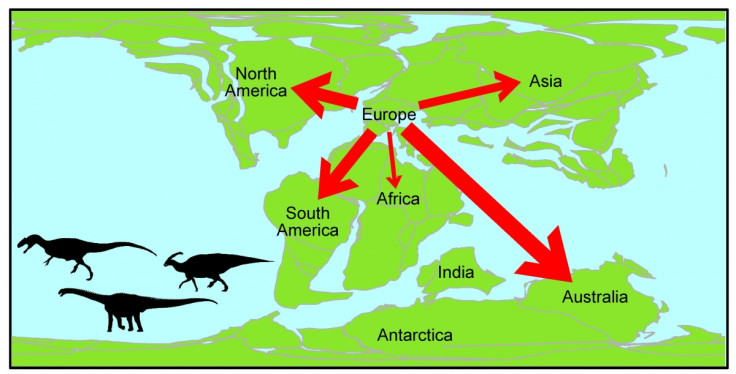Mystery exodus of dinosaurs from Europe plotted by scientists

Global dinosaur migration – including a mass exodus from Europe – has been plotted by scientists for the first time. Using every documented dinosaur fossil from around the world, researchers have shown how different species moved across the planet over millions of years.
A team from the University of Leeds created this visual depiction of dinosaur migration using network theory. This is normally used in computer science to look at connections – on social networks for example. However, scientists are increasingly using it in biology to look at various relationships and systems.
Published in the Journal of Biogeography, the team used fossil records from different dinosaur families found in different countries. They then combined this information to look at different periods in time. This allowed them to find connections, which help show how they migrated.
Their findings showed dinosaurs continued to migrate across the globe after the supercontinent Pangaea, which included modern-day North and South America, Africa, Eurasia, India, Australia and Antarctica, broke up, an event that began around 175 million years ago. Once separated, landmasses were separated by oceans.
Researchers believe the continued migration was facilitated by "temporary land bridges" that formed as a result of changes to sea level. This would have temporarily reconnected the continents – allowing for dinosaurs to move across them.

Alex Dunhill, leader of the study, said: "Such massive structures – spanning, for example, from Indo-Madagascar to Australia – may be hard to imagine. But over the timescales that we are talking about, which is in the order of tens of millions of years, it is perfectly feasible that plate tectonic activity gave rise to the right conditions for such land bridges to form."
Their findings also showed the mass exodus from Europe during the Early Cretaceous period, between 100-125 million years ago. While dinosaurs were leaving Europe, their map showed none were coming back in. Dunhill: "This is a curious result that has no concrete explanation. It might be a real migratory pattern or it may be an artefact of the incomplete and sporadic nature of the dinosaur fossil record."
While the reasons behind the dinosaurs leaving Europe are unknown, the researchers say their findings support the idea that while the break-up of the continents reduced migration, it did not stop it altogether.
The findings support the idea that, although continental splitting undoubtedly reduced intercontinental migration of dinosaurs, it did not completely inhibit it. They also said there is some evidence suggesting increased continental isolation could have played a role in extinction, but further research would be needed to examine this.
© Copyright IBTimes 2025. All rights reserved.






















